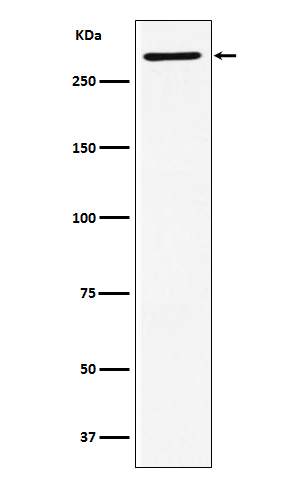Anti-EDD Rabbit Monoclonal Antibody
- SPECIFICATION
- CITATIONS
- PROTOCOLS
- BACKGROUND

Application
| WB |
|---|---|
| Primary Accession | O95071 |
| Host | Rabbit |
| Isotype | IgG |
| Reactivity | Human, Mouse |
| Clonality | Monoclonal |
| Format | Liquid |
| Description | Anti-EDD Rabbit Monoclonal Antibody . Tested in WB application. This antibody reacts with Human, Mouse. |
| Gene ID | 51366 |
|---|---|
| Other Names | E3 ubiquitin-protein ligase UBR5, 2.3.2.26, E3 ubiquitin-protein ligase, HECT domain-containing 1, HECT-type E3 ubiquitin transferase UBR5, Hyperplastic discs protein homolog, hHYD, Progestin-induced protein, UBR5, EDD, EDD1, HYD, KIAA0896 |
| Calculated MW | 309 kDa |
| Application Details | WB 1:500-1:2000 |
| Contents | Rabbit IgG in phosphate buffered saline, pH 7.4, 150mM NaCl, 0.02% sodium azide and 50% glycerol, 0.4-0.5mg/ml BSA. |
| Clone Names | Clone: 24U00 |
| Immunogen | A synthesized peptide derived from human EDD |
| Purification | Affinity-chromatography |
| Storage | Store at -20°C for one year. For short term storage and frequent use, store at 4°C for up to one month. Avoid repeated freeze-thaw cycles. |
| Name | UBR5 |
|---|---|
| Function | E3 ubiquitin-protein ligase involved in different protein quality control pathways in the cytoplasm and nucleus (PubMed:29033132, PubMed:33208877, PubMed:37478846, PubMed:37478862). Mainly acts as a ubiquitin chain elongator that extends pre-ubiquitinated substrates (PubMed:29033132, PubMed:37409633). Component of the N-end rule pathway: ubiquitinates proteins bearing specific N-terminal residues that are destabilizing according to the N-end rule, leading to their degradation (By similarity). Recognizes type-1 N-degrons, containing positively charged amino acids (Arg, Lys and His) (By similarity). Together with UBR4, part of a cytoplasm protein quality control pathway that prevents protein aggregation by catalyzing assembly of heterotypic 'Lys-11'-/'Lys-48'-linked branched ubiquitin chains on aggregated proteins, leading to substrate recognition by the segregase p97/VCP and degradation by the proteasome: UBR5 is probably branching multiple 'Lys-48'-linked chains of substrates initially modified with mixed conjugates by UBR4 (PubMed:29033132). Together with ITCH, catalyzes 'Lys-48'-/'Lys-63'-branched ubiquitination of TXNIP, leading to its degradation: UBR5 mediates branching of 'Lys-48'-linked chains of substrates initially modified with 'Lys-63'-linked conjugates by ITCH (PubMed:29378950). Catalytic component of a nuclear protein quality control pathway that mediates ubiquitination and degradation of unpaired transcription factors (i.e. transcription factors that are not assembled into functional multiprotein complexes): specifically recognizes and binds degrons that are not accessible when transcription regulators are associated with their coactivators (PubMed:37478846, PubMed:37478862). Ubiquitinates various unpaired transcription regulator (MYC, SUPT4H1, SUPT5H, CDC20 and MCRS1), as well as ligand- bound nuclear receptors (ESR1, NR1H3, NR3C1, PGR, RARA, RXRA AND VDR) that are not associated with their nuclear receptor coactivators (NCOAs) (PubMed:33208877, PubMed:37478846, PubMed:37478862). Involved in maturation and/or transcriptional regulation of mRNA by mediating polyubiquitination and activation of CDK9 (PubMed:21127351). Also acts as a regulator of DNA damage response by acting as a suppressor of RNF168, an E3 ubiquitin-protein ligase that promotes accumulation of 'Lys-63'-linked histone H2A and H2AX at DNA damage sites, thereby acting as a guard against excessive spreading of ubiquitinated chromatin at damaged chromosomes (PubMed:22884692). Regulates DNA topoisomerase II binding protein (TopBP1) in the DNA damage response (PubMed:11714696). Ubiquitinates acetylated PCK1 (PubMed:21726808). Acts as a positive regulator of the canonical Wnt signaling pathway by mediating (1) ubiquitination and stabilization of CTNNB1, and (2) 'Lys- 48'-linked ubiquitination and degradation of TLE3 (PubMed:21118991, PubMed:28689657). Promotes disassembly of the mitotic checkpoint complex (MCC) from the APC/C complex by catalyzing ubiquitination of BUB1B, BUB3 and CDC20 (PubMed:35217622). Plays an essential role in extraembryonic development (By similarity). Required for the maintenance of skeletal tissue homeostasis by acting as an inhibitor of hedgehog (HH) signaling (By similarity). |
| Cellular Location | Nucleus. Cytoplasm |
| Tissue Location | Widely expressed. Most abundant in testis and expressed at high levels in brain, pituitary and kidney |

Thousands of laboratories across the world have published research that depended on the performance of antibodies from Abcepta to advance their research. Check out links to articles that cite our products in major peer-reviewed journals, organized by research category.
info@abcepta.com, and receive a free "I Love Antibodies" mug.
Provided below are standard protocols that you may find useful for product applications.
If you have used an Abcepta product and would like to share how it has performed, please click on the "Submit Review" button and provide the requested information. Our staff will examine and post your review and contact you if needed.
If you have any additional inquiries please email technical services at tech@abcepta.com.













 Foundational characteristics of cancer include proliferation, angiogenesis, migration, evasion of apoptosis, and cellular immortality. Find key markers for these cellular processes and antibodies to detect them.
Foundational characteristics of cancer include proliferation, angiogenesis, migration, evasion of apoptosis, and cellular immortality. Find key markers for these cellular processes and antibodies to detect them. The SUMOplot™ Analysis Program predicts and scores sumoylation sites in your protein. SUMOylation is a post-translational modification involved in various cellular processes, such as nuclear-cytosolic transport, transcriptional regulation, apoptosis, protein stability, response to stress, and progression through the cell cycle.
The SUMOplot™ Analysis Program predicts and scores sumoylation sites in your protein. SUMOylation is a post-translational modification involved in various cellular processes, such as nuclear-cytosolic transport, transcriptional regulation, apoptosis, protein stability, response to stress, and progression through the cell cycle. The Autophagy Receptor Motif Plotter predicts and scores autophagy receptor binding sites in your protein. Identifying proteins connected to this pathway is critical to understanding the role of autophagy in physiological as well as pathological processes such as development, differentiation, neurodegenerative diseases, stress, infection, and cancer.
The Autophagy Receptor Motif Plotter predicts and scores autophagy receptor binding sites in your protein. Identifying proteins connected to this pathway is critical to understanding the role of autophagy in physiological as well as pathological processes such as development, differentiation, neurodegenerative diseases, stress, infection, and cancer.


